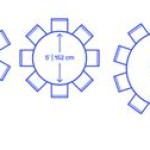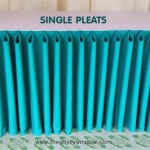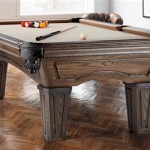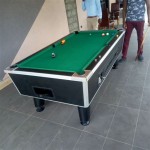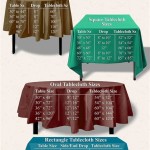How To Make A Stainless Steel Table Top
A stainless steel table top offers several advantages, including durability, hygiene, and aesthetic appeal. They are commonly used in commercial kitchens, workshops, laboratories, and even modern homes. Fabrication may seem daunting, but with careful planning, the right tools, and a step-by-step approach, constructing a stainless steel table top is a manageable task. This article details the process of crafting a stainless steel table top, outlining the necessary materials, tools, and steps for a successful outcome.
Planning and Preparation
The foundation of any successful fabrication project lies in meticulous planning. This phase involves determining the table top's dimensions, selecting the appropriate grade of stainless steel, and accounting for the intended application. A well-defined plan minimizes errors and ensures efficient material utilization.
Determining Dimensions: Begin by accurately measuring the space where the table top will be installed. Consider the overall size requirements, including length, width, and thickness. If the table top needs to accommodate specific equipment or activities, incorporate these considerations into the dimensional planning. Precise measurements are critical for ensuring a proper fit and functionality.
Selecting Stainless Steel Grade: Stainless steel comes in various grades, each offering different properties. Grade 304 is widely used due to its excellent corrosion resistance, weldability, and formability. It is suitable for most general-purpose applications. Grade 316 offers enhanced corrosion resistance, particularly against chlorides, making it ideal for marine or chemical environments. The choice depends on the specific demands of the application and the potential exposure to corrosive substances. Considerations should also be given to the gauge or thickness of the stainless steel. Thicker gauges offer greater strength and durability but come at a higher cost and are more difficult to work with. A 16 or 18-gauge stainless steel sheet is generally suitable for table tops, offering a balance between strength and workability.
Accounting for Application: The intended use of the table top significantly influences its design and construction. For example, a table top used in a commercial kitchen will require a robust design to withstand heavy use, frequent cleaning, and potential impacts. A table top in a laboratory setting might require specific features like upturned edges to contain spills or resistance to particular chemicals. Understanding the application ensures that the constructed table top meets the necessary performance requirements.
Once the planning is complete, it's time to gather the necessary materials and tools. Safety is paramount, so ensure that all protective equipment is available and used correctly.
Materials and Tools Required
Successful fabrication relies not only on a sound plan but also on having the right materials and tools. The selection of appropriate tools and high-quality materials is crucial for achieving a professional and durable finished product. Safety equipment is also an indispensable element in the preparation phase.
Stainless Steel Sheet: As discussed earlier, select the appropriate grade and gauge of stainless steel based on the intended application and budget. Obtain the sheet in the required dimensions, potentially ordering it pre-cut from a metal supplier to minimize waste and cutting effort.
Reinforcement Materials (Optional): Depending on the table top's size and anticipated load, reinforcement might be necessary. This can involve using steel tubing, angle iron, or plywood backing. These materials provide additional support and prevent the table top from sagging or bending under heavy loads. The choice of reinforcement material depends on the specific requirements of the project and the desired aesthetic.
Fasteners: Select appropriate fasteners for attaching the stainless steel sheet to the frame or reinforcement. Stainless steel screws or rivets are recommended to prevent corrosion. The type of fastener will depend on the materials being joined. For example, if attaching the stainless steel to a wooden frame, wood screws are appropriate. For attaching to a steel frame, self-tapping metal screws or rivets are suitable.
Welding Equipment (Optional): If the design involves welding, a suitable welding machine is required. TIG (Gas Tungsten Arc Welding) is often preferred for stainless steel due to its precision and clean welds. Ensure you have the necessary safety equipment for welding, including a welding helmet, gloves, and protective clothing.
Cutting Tools: Various cutting tools can be employed, including:
- Angle Grinder with Cutting Discs: Suitable for cutting straight lines and curves in stainless steel.
- Metal Shear: A power tool that cuts sheet metal cleanly and efficiently, generally producing less burr than an angle grinder.
- Nibbler: A specialized tool for cutting complex shapes and curves in sheet metal.
- Plasma Cutter: Offers a clean and fast cut, particularly useful for thicker gauges of stainless steel.
Grinding and Finishing Tools: These tools are used to smooth edges, remove burrs, and polish the stainless steel surface.
- Angle Grinder with Grinding Discs: Used to remove sharp edges and weld spatter.
- Sanding Belts and Pads: Used to achieve a smooth and uniform surface finish.
- Polishing Compounds and Buffing Wheels: Used to create a high-gloss finish on the stainless steel.
Measuring and Marking Tools: Essential for accurate cutting and assembly.
- Measuring Tape: For precise measurements.
- Straight Edge: For marking straight lines.
- Combination Square: For marking right angles.
- Soapstone or Marker: For marking cutting lines on the stainless steel.
Safety Equipment: Indispensable for protecting yourself during the fabrication process.
- Safety Glasses: To protect eyes from flying debris.
- Gloves: To protect hands from sharp edges and heat.
- Ear Protection: To protect hearing from loud noises.
- Respirator or Dust Mask: To protect lungs from dust and fumes.
- Welding Helmet (if welding): To protect eyes and face from the intense light and heat of welding.
Fabrication Process
The fabrication process involves cutting, shaping, and assembling the stainless steel components to create the table top. Each step requires precision and attention to detail to ensure a high-quality finished product. Safety precautions must be followed throughout the process.
Cutting the Stainless Steel: Using the selected cutting tool and following the marked lines, carefully cut the stainless steel sheet to the desired dimensions. Secure the sheet firmly to prevent movement during cutting. Wear appropriate safety glasses and gloves to protect yourself from flying debris and sharp edges. If using an angle grinder, employ a slow and steady motion to avoid overheating the metal, which can cause discoloration or warping. Utilize cutting fluid, particularly when using a metal shear, to improve the cut quality and extend the life of the cutting tool. When the primary cut is complete, inspect the edges for any remaining burrs or sharp points.
Preparing the Frame (if applicable): If the table top requires a frame, construct it from steel tubing, angle iron, or wood. Ensure the frame is square and level. Weld steel components together securely, or assemble the wooden frame with screws and glue. The frame should provide adequate support for the stainless steel sheet and distribute the load evenly. Any imperfections in the frame will be reflected in the final table top, so precision is essential.
Attaching the Stainless Steel to the Frame: Position the cut stainless steel sheet onto the frame. Use clamps to hold it securely in place. If welding the stainless steel to the frame, use TIG welding to create clean and strong welds. Employ spot welds to tack the sheet in place and prevent warping. If using screws or rivets, pre-drill pilot holes through the stainless steel and into the frame. Space the fasteners evenly to ensure a secure and uniform attachment. Consider using a sealant or adhesive between the stainless steel and the frame to prevent vibrations and provide additional support.
Finishing the Edges: Once the stainless steel is securely attached, focus on finishing the edges. Use an angle grinder with a grinding disc to smooth any sharp edges or weld spatter. Pay particular attention to corners and edges that may come into contact with people. After grinding, use sanding belts and pads to further refine the edges and create a smooth, uniform surface. Start with a coarse grit sandpaper and gradually move to finer grits. For a high-gloss finish, use polishing compounds and buffing wheels. Apply the compound to the buffing wheel and gently polish the stainless steel surface. Work in small sections and avoid overheating the metal.
Adding Features (Optional): Depending on the intended use of the table top, add any necessary features such as upturned edges, backsplashes, or cutouts for sinks or equipment. Upturned edges can be created by bending the edges of the stainless steel sheet upward using a metal brake or forming tool. Securely weld or fasten the upturned edges to the table top. Backsplashes can be constructed from separate pieces of stainless steel and attached to the back of the table top with welds or fasteners. Cutouts can be created using a nibbler or plasma cutter, ensuring accurate measurements and smooth edges.

Diy Metal Table Top And Hearth

How To Make Stainless Steel Inox Work Table 1600x700x850mm

Stainless Steel Top With Underframe Tables Backsplash China Work Table Made In Com

Simple Flat Packed Stainless Steel Worktable Easy To Assemble For Equipment Stand China Restaurant Table Preparing Made In Com

Industrial Stainless Steel Kitchen Working Metal Table With Counter Top Shelves China Work Station Operation Made In Com

Vogue Premium Stainless Steel Table With Upstand 600x600x900mm Da337 Fletchers Supplies

Stainless Steel Table Top With Base

Customized 201 304 Stainless Steel Kitchen Work Table For Home Dining And Commercial Equipment Square Single Layer China Workbench Made In Com

Stainless Steel Table Temu

Bunpeony 36 In Nsf Stainless Steel Kitchen Utility Table Scf054 The Home Depot

